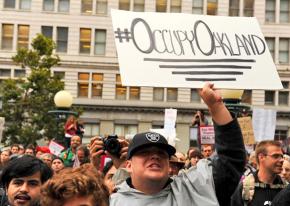We are all Oakland
The call for a general strike in Oakland to protest the savage police attack on Occupy protesters is linking the movement more closely with the organized working class.
IN A protest against political repression and a show of working-class muscle, thousands will take the streets of Oakland, Calif., November 2 to answer the call for a general strike by the Occupy movement there--and thousands more will show their solidarity in day-of-action demonstrations around the country.
Shutting down a city the size of Oakland with a Greece-style general strike is a tall order in a week's time--especially since the last general strike in the U.S. was in 1946 (in Oakland, as it happens). Nevertheless, workers' action will be central to the all-day series of protests planned for November 2, as a response to the brutal police attack on Occupy protesters that resulted in a near-fatal injury suffered by Iraq war veteran Scott Olsen.
That's why the effort to build a general strike in Oakland marks a critical step for the Occupy movement as a whole.
Besides taking a stand in defense of free speech and the right to peaceably assemble, the action represents an effort to tap the social power of the working class--and its organized section, the unions--from which the Occupy movement can both gather strength to defend itself from repression and organize its power for the big struggles ahead.
THE SHOWDOWN in Oakland also makes it clear who the friends of the Occupy movement are--and are not. It's difficult to find a more liberal Democratic mayor than Jean Quan, a onetime community organizer. But when Democratic mayors began sending police to crack down on Occupy protests across the U.S. over the past several weeks, it was Quan who oversaw by far the harshest attack.
The repression in Oakland on October 25 included not just city cops in riot gear, but personnel from 17 different other law enforcement agencies. One of those cops fired a tear gas canister that struck Scott Olsen, a 24-year-old member of Veterans for Peace, in the head. When his comrades gathered around him to try to help, police fired a stun grenade into their midst. Eventually, protesters--not the police--carried Olsen to the hospital, where he has been ever since with a fractured skull and brain injury.
But this was only the most vicious example of a national drive to crush the Occupy movement. Democratic mayors in Chicago, Atlanta, Denver, Boston, Cincinnati, Nashville and other cities have also ordered police to arrest hundreds of Occupy activists.
With local governments pushing through relentless budget cuts and attacks on public-sector unions, the mayors fear--correctly--that the Occupy encampments could become centers of resistance to austerity.
But in Oakland, Olsen's severe injury and the mass arrests didn't destroy the movement, but drew new forces into the struggle. The day after the attack--with Quan and other city officials forced to retreat from their defense of the police attack--Occupy demonstrators retook Oscar Grant Plaza across from City Hall. The evening protest was the largest yet, and the Occupy General Assembly voted 1,484 to 46 to call for the November 2 general strike.
The response to the strike call--not only in the Bay Area, but around the country--shows that activists understand standing up for Occupy Oakland is a way to stand up for Occupy everywhere.
One key player in the November 2 action is the Oakland Education Association, whose executive board endorsed the general strike and day of action. High school and college students are planning walkouts, and elementary teachers will take younger kids to libraries for a teach-in on the struggle.
Marches and rallies during the day will include community picket lines at the Port of Oakland in a bid to gain the support of International Longshore and Warehouse Union members. Officers of the Oakland chapter of Service Employees International Union Local 1021 encouraged members to take a personal day to attend the rally.
The Alameda Labor Council, which represents area unions, issued a statement of support for what it calls a "day of action" in which "individual unions and your members are encouraged to express solidarity in whatever form you find appropriate," wrote Josie Camacho, the council's executive secretary-treasurer. "This Day of Action on November 2 will be a public demonstration of support for the right to peaceably assemble without interference, and against the growing wealth and income inequality created by Wall Street and the actions of the richest 1 percent."
Even the AFL-CIO--which not long ago would have ignored a general strike call from a mass meeting of activists--highlighted labor's support for the Oakland action, and quoted federation President Richard Trumka calling police attacks on Occupy protests a "tremendous dishonor to America when the voices for the powerless are suppressed by the powerful--the top 1 percent."
Other union activists are planning noontime walkouts or encouraging sickouts. Each aspect of the strike--from teach-ins to logistics--involves networks of people, coming together to organize. Many of them are veteran activists, and many more are new to political struggle. Meanwhile, encouragement has poured in from across the U.S., with statements of support from unions and local Occupy groups, many of which have called their own solidarity actions for November 2.
ORGANIZED LABOR'S response to the Oakland general strike call is the latest and most important example of union support for Occupy struggles around the U.S.
In New York City, labor provided early help for Occupy Wall Street, and some 20,000 people marched to the Liberty Plaza encampment October 5 in a demonstration backed by key New York unions. Labor was also instrumental in defending Liberty Plaza from a police-led "cleanup" of the park October 14--and getting out the word for the mass convergence of upwards of 100,000 people in Times Square the following night. Occupy Wall Street's labor outreach committee has been a hub of labor-related protests, such as a Verizon workers' rally and march October 21.
Local labor councils have organized solidarity marches in other cities as well, with thousands of union members demonstrating in Los Angeles and Portland, Ore. Occupy activists have formed labor outreach committees in Chicago, Seattle and other cities to build ties with unions to work together on common struggles. And in San Francisco, hundreds of union members, including a number of local officials, stayed late into the night on October 26 to defend the Occupy SF encampment from a police raid.
Despite these shows of solidarity, the unions' involvement has raised concerns among some Occupy members, who voice fears that labor is trying to "co-opt" the movement.
Certainly, the unions will pursue their own agenda. For example, AFSCME President Gerald McEntee told a reporter that he expected activists to turn their attention to the 2012 election.
But it's wrong to conclude that unions are simply out to absorb and redirect the movement--even if they were capable of doing so.
Labor is responding to a groundswell of activism and widespread support for Occupy among millions of working people, both inside and outside the unions. The dynamic is similar to the mobilization against anti-labor legislation in Wisconsin last winter, when a sick-out by teachers spurred an occupation of the Capitol, and the unions mobilized for several mass demonstrations of more than 100,000.
In the end, Wisconsin's Republican Gov. Scott Walker was able to ram through his anti-union law--and union leaders demobilized the protests in favor of a recall election effort that was only partially successful.
But Occupy, while tapping into the same working class radicalization that fueled the Wisconsin revolt, is a far broader movement. It is a national uprising, first of all--and it targets social inequality, denounces big-money control of both political parties, and raises questions about the system itself.
While union officials will continue to pursue their electoral agenda, the Occupy movement is providing an arena for advancing the class struggle in the here and now, in cities around the country--for building support for and participation in fightbacks against bosses and politicians who are attempting to impose a deep and permanent cut in living standards.
The Oakland general strike call is a big advance in that effort, with its focus on longshore workers, one of the most powerful unions in the U.S., and teachers, who make up the largest group of organized workers in the country.
And by raising the call for a general strike, Occupy Oakland is pointing the movement toward the rich history of working-class struggle in the U.S.--such as the 1934 general strikes in Toledo, Minneapolis and San Francisco that set the stage for labor's biggest upsurge in the late 1930s.
General strikes on the scale of those historic struggles can't simply be summoned with a call for one. They flow from earlier conflicts--as in Oakland--and often those earlier struggles are modest. However, every picket line and march and rally and action can knit together the activists of today who can play a role in the bigger struggles of tomorrow.
And as the struggle in Oakland shows, "tomorrow" could come sooner than we think.



